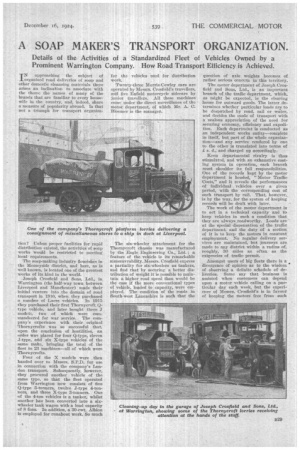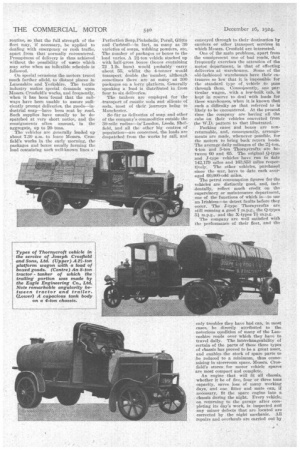A SOAP MAKER'S TRANSPORT ORGANIZATION.
Page 13

Page 14

Page 15

If you've noticed an error in this article please click here to report it so we can fix it.
Details of the Activities of a Standardized Fleet of Vehicles Owned by a Prominent Warrington Company. How Road Transport Efficiency is Achieved.
IN approaching the subject of organized road deliveries of soap and other domestic cleansing materials there arises an inclination to associate with the theme the names of many of the brands that are familiar to every housewife in the country, and, indeed, share
measure of popularity abroad. Is that not a triumph for transport organiza tion? Unless proper facilities for rapid distribution existed, the activities of soap works would be restricted to meeting local requirements.
The soap-making industry flourishes in the Merseyside district, and here, as is well known, is located one of the greatest works of its kind in the world.
Joseph Crosfield and Sons, Ltd., in Warrington (the half-way town between Liverpool and Manchester) made their initial venture into the domain of road transport in 1910, when they purchased a number of Lacre vehicles. In 1915 they purchased their first Thornycroft.Qtype vehicle, and later bought three J modeln, two of which were commandeered for war service. The company's experience with their original Thornycrof is was so successful that, upon the conclusion of hostilitieS, an order was placed for four Q-type, eleven J-type, and six X-type vehicles of the same make, bringing the total of the fleet to23 machines—all of which were Thornycrofts.
Four of the X models were then handed over to Messrs. S.P.D. for use in connection with the company's London transport. Subsequently, however, they procured another vehicle of the same type, so that the fleet operated from Warrington now consists of five Q-type 5-tonners, twelve J-type 4-tonnets, and three X-type 3-tonners. One of the 4-ton vehicles is a tanker, whilst another has been converted into a sixwheeler tank wagon with a load capacity of 8 fons. In addition, a 30-cwt. Albion is employed for runabout work. So much for the vehicles used for distribution work.
Twenty-three Morris-Cowley ears are operated by Messrs. Crosfield's travellers, and five Enfield motorcycle sidecars by junior travellers. All these machines come under the direct surveillance of the motor department,of which Mr. A. C. Bloomer is the manager.
The six-wheeler attachment for the Thornycroft chassis was manufactured by the Eagle Engineering Co., Ltd. ; a feature of the vehicle is its remarkable manceuvrability. Messrs. Crosfield express apartiality for six-wheelers as tankers, and find that by securing a better distribution of weight it is possible to maintain a higher road speed than would be the ease if the more conventional types of vehicle, loaded to capacity, were employed. The condition of the roads in SMith-west Lancashire is such that the
question of axle weights becomes of rather serious concern in this territory.
The motor department of Joseph Crosfield and Sons, Ltd., is an important branch of the traffic department, which, as might be expected, is the clearing house for outward goods. The latter determines whether particular loads are to be despatched by road, rail or -water, and decides the mode of transport with a zealous appreciation of the need for securing economy, efficiency and expedition. Each department is conducted as an independent works entity—complete in itself, but part of the whole organization—and any service rendered by one to the other is translated into terms of 1 s. d., and charged up -accordingly.
Keen departmental rivalry is thus stimulated, and with an exhaustive costing system in operation, each branch must sinouldcr its full responsibilities. One of the records kept by the motor department is headed, "Motor Traffic Costs," and it reveals the performances of individual vehicles over a given period, with the corresponding cost of such transport by rail. That, however,. is by the way, for the system of keeping records will be dealt with later.
The work of the motor department is to act in a technical capacity and to keep vehicles in such a Condition that they are always roadworthy. Loads are at the special dispensation of the traffic department, and the duty of a section of it is to keep the motors in constant employment. No regular delivery services are maintained, but journeys are made to any district within a radius of, roughly, 30 miles as often as the exigencies of traffic permit.
Amongst users of big fleets there is a divergence of opinion as to the wisdom of observing a definite schedule of deliveries. Some say that business is assisted when customers can depend upon a motor vehicle calling on a particular day each week, but the experience of Messrs. Crosfield's is in favour of keeping the motors free from such
routine, so that the full strength of the fleet may, if necessary, be applied to dealing with emergency or rush traffic, apart from that normally encountered. Promptness of delivery is thus achieved without the possibility of waste which may arise when an inflexible schedule is followed.
On special occasions the motors travel much farther afield, to distant places in Lancashire and Yorkshire. The textile industry makes special demands upon Messrs. Crosfield's works, and frequently, when it has been found that the railways have been unable to assure sufficiently prompt deliveries, the goods—industrial soap—have been sent by road. Such supplies have usually to be despatehed at very short notice, and the consigunients often amount, in the aggregate, up to 20tons.
The vehicles are generally loaded up about 7.30 a.m. to leave Messrs. Crosfield's works in the early morning, the packages and boxes usually forming the load containing such well-known lines a,
Perfection Soap,Pinkobolie, Persil, Glitto and Carbbsil—in fact, as many as 30 varieties of soaps, wdshing powders, etc. The number of packages or boxes to the load varies. A 21-ton vehicle Stacked up with half-gross boxes (boxes containing 72 . 1 lb. bars) wOuld probably carry about 55, whilst the 4-tanner would transport double the number, although, sometimes there are as many as 300 packages on a lorry platform. Generally speaking a load is distributed in from four to six deliveries.
The tankers are employed for the transport of caustic soda and silicate of soda, most of their journeys. being to Manchester.
So far as deliveries of soap • and other of the company's commodities outside the 30-mile radius—in London, Leeds, Sheffield, and all the other big centres of population—are concerned, the loads are despatched from the works by rail, and
conveyed through to their destination by carriers or other transport services in which Messrs. Crosfield are interested.
One of the main problems, apart from the omnipresent one of bad roads, that frequently exercises the attention of the motor department, is that of effecting deliveries at warehouses. Some of the old-fashioned warehouses have their entrances so low that it is impossible for the standard type of vehicle to pass through them. Consequently, one particular wagon, with a low-built Cab,, is kept in reserve to deal with loads for these warehouses, when it is known that such a difficulty as that referred to is likely to be encountered. At the present time the company are having all the cabs on their vehicles converted from the W.D. pattern to that illustrated.
Packing eases and boxes are nonreturnable, and, consequently, arrangements are made, whenever possible, for the motors to bring back return loads. The average daily mileages of the 2a-tou, 4-ton and 5-ton Thornyerofts are between 60 and 65. The original Q-type and J-type vehicles have run to date 142.179 miles and 163,853 miles respectively. The other vehicles, purchased since the war, have to date each averaged 60,000-odd miles.
The petrol 'consumption figures for the vehicles are distinctly good, and, incidentally, reflect much credit on the supervisory or maintenance department, one of the functions of which is—to use an Irishism—to detect faults before they occur. The 3-type Thornyerofts are still running a good 7 ,m.p.g., the Q-types 5i m.p.g., and the X-types 71 m.p.g.
The company are well satisfied with the performance of their fleet, and the only troubles they have had can, in most cases, be directly attributed to the notorious condition of many of the Lancashire roads over which they have to travel daily. The intdrchangeability of certain of the parts of these three types of chassis has proved to be a great asset, and enables the stock of spare parts to be reduced• to a minimum, thus economizing in storeroom space. Messrs. Crosfield's stores for motor vehicle spares are most compact and complete.
An engine that will fit all chassis, whether it be of five, four or three tons capacity, saves loss of many working days, and one fitter and mate can, if necessary, fit the spare engine into a chassis during the night. Every vehicle, on returning to the garage after completing its day's work, is inspected and any minor defects that are located are corrected by the night mechanic. All repairs and overhauls are carried out by the company's own staff in the workshops, which are extremely well equipped with modern plant and appliances. The fleet as a whole, busily employed as it is, displays obvious signs of the painstaking care bestowed upon it. On Saturday mornings the drivers and mates attend to their charges. Certain of the engine _parts are kept well polished, and inaccessible parts of the transmission receive detailed attention.
The keeping of correct and complete records has been carried out by Messrs. Crosfield to a point of delicate precision. There is no " shifting " of charges, and, as has been explained, the motor department is worked to some extent on competitive lines; its existence depends upon its ability to be self-supporting. Therefore, while it has a full quota of debits, it also claims a substantial number of good credits.
The driver's daily time sheet, which is made out by the traffic department, so far as possible on the evening before the deliveries are to be made, is, of course, the basis of the system of keeping records. As will be seen from our reproduction of a specimen sheet, as much information is required concerning return loads as for the outward consignments.
The drivers' report sheets are checked with the journeys sheet, which is entered
up in the traffic office and made out in quadruplicate, one copy being kept by the• motor department, another by the warehouse, a third -by the traffic depart
ment, and another filed. Separate accounts are kept for each vehicle, and each month the costs are summarized on a special form.
Eventually these are transferred to the motor vehicles service sheet, on which is given a bird's-eye view of the performances and costs of each vehicle over a period. The completed form which we reproduce shows authentic figures for representative types of vehicle during the month of May. They speak for themselves and are a model in clarity. An auxiliary record to this is contained on a motor traffic costs sheet, which ts summary of the driver's reports interpreted into terms of actual work done, and the comparable cost by railway.
The motor department distributes its charges for transport between 30 different departments of Messrs. Crosfield's works, and in the "charge accounts" columns of the motor vehicles service sheet is shown the name of the section debited with transport service, and other brief but essential particulars.
Special forms are used when return loads are arranged for. A form headed, 'Motor traffic," is made out by the motor department in triplicate. One copy is handed by the driver collecting the goods to the sender, a second is delivered with the goods (being in the nature of an advice note), whilst the third forms a receipt for goods delivered, and is returned by the driver with his daily time sheet.






























